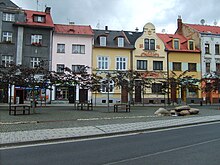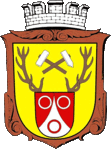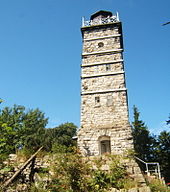Nejdek
| Nejdek | ||||
|---|---|---|---|---|
|
||||
| Basic data | ||||
| State : |
|
|||
| Region : | Karlovarský kraj | |||
| District : | Karlovy Vary | |||
| Area : | 5229.0308 ha | |||
| Geographic location : | 50 ° 19 ′ N , 12 ° 44 ′ E | |||
| Height: | 568 m nm | |||
| Residents : | 7,807 (Jan 1, 2019) | |||
| Postal code : | 362 21 | |||
| License plate : | K | |||
| traffic | ||||
| Railway connection: | Karlsbad – Johanngeorgenstadt | |||
| structure | ||||
| Status: | city | |||
| Districts: | 10 | |||
| administration | ||||
| Mayor : | Vladimír Benda (as of 2009) | |||
| Address: | nám. Karla IV. 239 362 21 Nejdek |
|||
| Municipality number: | 555380 | |||
| Website : | www.nejdek.cz | |||
| Location of Nejdek in the Karlovy Vary district | ||||

|
||||
Nejdek ( German Neudek ) is a town in Karlovarský kraj in the Czech Republic .
geography
location
The city is located in the Bohemian part of the Erzgebirge in the valley of the Rolava ( Rohlau ), a left tributary of the Ohře ( Eger ). The ridge of the towering, 974 m high Tisovský vrch ( Peindlberg ) rises north above the town . The city is located on the old trade and pass road from Leipzig to Karlovy Vary ( Karlsbad ), which crossed the border between Oberwildenthal and Jelení (Hirschenstand), but is now only used as a walking border crossing.
City structure
The town consists of the districts Bernov ( Bernau ), Fojtov ( Voigtsgrün ), Lesík ( Mühlberg ), Lužec ( Kammersgrün ), Nejdek ( Neudek ), Oldřichov ( Ullersloh ), Pozorka ( Gibacht ), Suchá ( Thierbach ), Tisová ( Eibenberg ) and Vysoká Štola ( Hohenstollen ), which also form cadastral districts. Basic settlement units are Bernov, Fojtov, Kraslická, Lesík, Letná, Lužec, Nejdek-sídliště, Nejdek-střed, Nová Suchá ( Neuthierbach ), Nový Fojtov ( Neuvoigtsgrün ), Oldřichov (Ullersloh), Oldřichov (Ullersloh), Pozthorka, Prývod . Tisová, U Rolavy, Východní Předměstí and Vysoká Štola.
Neighboring places
| Vysoká Pec (blast furnace near Neudek) | Nové Hamry (Neuhammer near Karlsbad) | Pernink (Bärringen) |
| Šindelová (Schindl Forest) |

|
Merklín (Merkelsgrün) |
| Černava (Schwarzenbach), Jindřichovice (Heinrichsgrün) | Božičany (Poschetzau), Nová Role (Neu Rohlau), Smolné Pece (Pechöfen) | Děpoltovice (Tüppelsgrün), Hroznětín (Lichtenstadt) |
history


Until the 16th century
Neudek is the oldest mining town of West Erzgebirge and was probably created by the Upper Franconian Zinnseifner towards the end of the 13th century under the castle Neudek settled, probably Konrad Built in the Knights Plick, which is therefore to be regarded as the founder of the town. The miners had followed the course of the Rohlau River and advanced into the area. The previously uninhabited territory belonged to the Teplá Monastery . The new settlers found extensive tin deposits here.
In 1340 Konrad's son, the knight Peter Plick, acquired the entire fiefdom of the Teplá Monastery so that it had all the main tin sites in the surrounding area. Neudek is mentioned for the first time in the document. In the course of the 14th century, solid rock was extracted here in addition to soap mining. In 1410 the Plicks sold the rule to the Cheb patrician Hans Forster. In addition to the castle and all its affiliations, he also acquired the little town below. An iron hammer is also mentioned, which also suggests iron ore mining. Just one year later, in 1413, King John of Bohemia enfeoffed Johann Malersik with Neudek. In 1419 the brothers Nikolaus and Hans Frasen received it from King Wenceslaus of Bohemia.
In 1444 the rule came to Count Mathias Schlick, who remained with his heirs until the end of the 16th century. Count Schlick gave Neudek its own coat of arms, promoted mining and helped the town to flourish. In 1454 a tin smelter was built. In 1494, the Neudek forest tin law is mentioned for the first time, a forerunner of the later mountain order that regulated tin soap mining in the Neudek manor . In 1545 the area received its own mining authority with a miner.
17th century
In 1602 Count Stephan Schlick sold Neudek to his cousin Friedrich Colonna Freiherr von Fels . In the same year the place was officially granted city privileges. The plague raged in 1613 and 1626. In 1618 Anna Barbara von Fels confirmed the privileges. On July 22, 1626, the formal reintroduction of Catholic worship took place. All Lutherans had to leave the country. Neudek was confiscated by the state. Mining largely came to a standstill due to the Thirty Years War . In 1633 the rule came to Count Hermann Czernin von Chudenitz , who paid for 73,000 shock Meissner groschen. In 1634 the city was plundered by the Swedes and captain Georg Putz was captured. Most of the inhabitants fled into the woods. In 1639 eleven regiments of imperial soldiers were approaching Neudek. In 1648 peace came.
As early as the 15th century, the city had a butcher, linen weaver and white tanner guild, which was confirmed and given privileges by Count Czernin in 1646. In 1667 the citizens' hospital was built. After the decline of mining in the 17th century, the population made a living mainly by working at home. Button-making, weaving and lace making were of the greatest importance .
The Neudek population also took part in the peasant uprising of 1680. Despite a warning from Count Humprecht Johann Czernin , the rebels resisted the military and withdrew armed into the mountains or fled across the border into Saxony. After the crackdown, the ringleaders, the Schmal farmers from Drahowitz and Heine from Fischern, were picked up by the Imperial General Hanaut, dragged to Neudek and executed on the Galgenberg. Others received the death penalty, which, however, was not carried out but turned into forced labor. According to the imperial decree of April 7, 1680, Neudek had lost all town privileges and the inhabitants had lost their civil status until further notice.
Count Humprecht Johann Czernin introduced sheet metal production in Neudek in the second half of the 17th century. Several rod hammers were in operation above Neudek, below was a sheet metal hammer mill. In 1680 it was the Humbrechts tin hammer mill named after the Count . The iron bars produced in the bar hammers were transported in carts down to the sheet metal hammer. It also formed the material for the upper, middle and lower wire mills, the latter being on Neudeker Fluren in place of the later paper mill. In addition, Count Czernin had a new manorial castle built and a castle lane laid out. The new settlement was named Humprechtsfeld .
18th century
The sexton Maximilian Danhammer received the last death sentence for robbery and desecration in 1708 . In 1710 there were 156 houses in Neudek. In 1715 a Trinity column or plague column was set up on the market square . In 1719 a Marian column was added. In 1721 the town hall burned down. In 1734 the Counts Czernin ceded Neudek, Gießhübel and Engelhaus to Count Adam von Hartig for financial reasons . In the Seven Years' War the Prussians invaded the area. In 1761 the new hospital was built.
The great famine and plague epidemic in the years 1771 to 1772 killed around 1300 people in the parish. The cemetery could no longer accommodate the dead. Due to a lack of space, the deceased were buried behind the houses or the nameless dead were placed in the churchyard without notice. According to a file that was handed over to the emperor in Vienna in 1771, there was a shortage of grain in the Neudek rule as well as elsewhere in the Elbogen district. Part of the population lives from lace making, the others from begging. In summer, the mountain dwellers cut wood in the forests of Electoral Saxony, while their wives and children make lace at home. The earnings are not enough for daily bread. Adults and children ate grass like cattle in the meadows or ate boiled hay. In 1772, Empress Maria Theresa donated 400 florins to those in need. The introduction of the potato improved the situation somewhat.
In 1781 Emperor Joseph II abolished serfdom. The mountain jurisdiction was abolished and Neudek St. Joachimsthal was subordinated. In 1786 Johann Wolfgang von Goethe stopped in Neudek on his way to Karlsbad. On the way back he painted the tower rock. Because of over-indebtedness, Count Ludwig von Hartig sold Neudek, including Gießhübel, Schöberitz and Priesnitz to Count Johann Joseph von Stiebar in 1799.
19th century
In 1800 Neudek had 282 houses and around 1800 inhabitants. The first non-aristocratic owner of the estate was the wholesaler Anton Waagner from Leitmeritz , who bought Neudek in 1810. In 1828 the large landowner and textile entrepreneur Jakob Veith from Wallern in South Bohemia followed , who bequeathed it to his daughter Anna, who was married to Heinrich Freiherr von Kleist (1797–1876).
In 1847 the protective and municipal city comprised 311 houses with 2,225 inhabitants, of which 12 houses with 84 inhabitants formed the castle district (formerly Humprechtsfeld ), 1 parish church, 1 school, 1 burial chapel at Gottesacker, 1 manorial castle with administrative offices, 1 manorial and 1 urban Brewery, 1 hunter's house, 1 town hall, 3 restaurants, 3 inns, 1 pharmacy, 1 post office and 4 mills. Aside from the one- shift Siehdichvor with 3 houses (formerly a Vorwerk) was 1 official ironworks, 2 hammers and 1 spoon factory.
After the revolution of 1848/1849 , inheritance and patrimonial jurisdiction were abolished in the Austrian Empire and the Neudek judicial district was formed. A commission that began its work in April 1851 in Neudek had the task of negotiating compensation with the town and the villages.
On March 1, 1869, Anna von der Asseburg received the rule of Neudek and Tüppelsgrün from her father. She founded an orphanage in Neudek as the Anna Bernhard Orphanage Foundation . On September 30, 1881, she sold Neudek and Tüppelsgrün along with the Oberchodau estate to the Jewish banker Moritz Freiherr von Königswarter from Vienna and moved to Eastern Bohemia.
At the end of the 19th century, the city developed into an important industrial location. Here were u. a. the iron Werke AG Rothau-Neudek , worsted spinning mills and factories of wood and paper manufacturing resident. Since 1847, the headquarters of the lace factory Anton Gottschald & Comp ., Which was considered to be the oldest and most important company in lace production in the Austrian Empire, was located there.
20th century
Neudek had been the seat of the eponymous district in the Kingdom of Bohemia ( Neudek district ) since 1910 . After the First World War , Neudek was added to the newly created Czechoslovakia in 1919 . Due to the Munich Agreement , in which the integration of the Sudetenland into the German Reich was agreed under international law, Neudek belonged from 1939 to 1945 to the district of Neudek , administrative district of Eger , in the Reichsgau Sudetenland . Before 1945 the settlements Galgenberg, Grund, Hahnberg, Hahnhäuser, Hochtanne, Limnitz and Seifertberg belonged to Neudek. While there were 1978 inhabitants here in 1830, the population increased to 8441 by 1939. At the 1930 census, Neudek had 9042 inhabitants (269 of them Czechs).
Due to the Beneš decrees , the German residents were expelled in 1945 . Their property was confiscated by the Beneš decree 108 , the property of the Protestant church was liquidated by the Beneš decree 131 and the Catholic churches were expropriated . The then still independent Markt Göggingen took over the sponsorship for all Germans expelled from the city and the district Neudek in 1954, which was continued by the Fuggerstadt after the incorporation of Göggingen into Augsburg as part of the German regional reform of 1972 . In 1984 the local history museum for the city and district of Neudek was established there.
Demographics
| year | Residents | Remarks |
|---|---|---|
| 1783 | k. A. | 258 houses |
| 1830 | 1,978 | in 305 houses |
| 1847 | 2,225 | in 311 houses, including three Israelite families |
| 1869 | 2,865 | |
| 1880 | 3,404 | |
| 1890 | 3,574 | |
| 1900 | 4,740 | German residents |
| 1910 | 6,937 | |
| 1921 | 6,995 | thereof 6,753 (97%) Germans |
| 1930 | 9,042 | including 269 (3%) Czechs |
| 1939 | 8,448 |
| year | 1950 1 | 1961 2 | 1970 2 | 1980 3 | 1991 3 | 2001 3 | 2011 3 | 2016 3 |
|---|---|---|---|---|---|---|---|---|
| Residents | 6,404 | 7,317 | 7,929 | 8,893 | 8,180 | 8,600 | 8,145 | 7,990 |
politics
traffic
- In 1881 Neudek received a railway connection to Chodov ( Chodau ). In 1899 the Karlsbad – Johanngeorgenstadt railway was opened, giving the city a connection to neighboring Saxony.
- In 1913 the roads to Schwarzenbach ( Černava ) and Bärringen ( Pernink ) were rebuilt.
- In 1926 a bus line was opened via blast furnace ( Vysoká Pec ) and Trinksaifen ( Rudné ) to Frühbuß ( Přebuz ).
economy
With around 1500 employees, Witte Nejdek spol. s ro the city's largest employer. Locking systems for several European automobile manufacturers are produced in the halls at the old bus station. Witte Nejdek is a subsidiary of the German company Witte Automotive .
Sights (selection)
- City museum with an exhibition on folklore of the Ore Mountains (Náměstí Karla IV. 238)
- Remains of the Neudek Castle , climbable watch tower on a rock and surrounding wall with gate
- New Neudek Castle (completed in 1653)
- Roman Catholic Parish Church of St. Martin (built 1755–1757)
- Evangelical Church of the Redeemer (built in 1904)
- Trinity or plague column from 1715
- Lookout tower on the 977 m high Tisovský vrch (Peindlberg)
Twin cities
- Augsburg-Göggingen , Germany
- Johanngeorgenstadt , Germany
Personalities
literature
- Homeland register of the Neudek district. 2nd Edition. Home group Glück Auf Landkreis Neudek, Augsburg-Göggingen 1978, p. 327 ff.
- Josef Pilz: History of the City of Neudek. 2nd Edition. Municipality of Neudek, Neudek 1923.
- Vinzenz Uhl: Castles and palaces of the Ore Mountains and Egertal. Kaaden, 1935. (Neudek Castle and Palace)
Web links
Individual evidence
- ↑ http://www.uir.cz/obec/555380/Nejdek
- ↑ Český statistický úřad - The population of the Czech municipalities as of January 1, 2019 (PDF; 7.4 MiB)
- ↑ http://www.uir.cz/casti-obce-obec/555380/Obec-Nejdek
- ↑ http://www.uir.cz/katastralni-uzemi-obec/555380/Obec-Nejdek
- ↑ http://www.uir.cz/zsj-obec/555380/Obec-Nejdek
- ↑ Jaroslav Čechura: Selské rebelie roku 1680 . Libri, 2001, ISBN 978-80-7277-064-9 ( google.de [accessed April 27, 2019]).
- ↑ Westermanns monthly notebooks . 1875 ( google.de [accessed April 27, 2019]).
- ↑ Josef Pilz: History of the city of Neudek . Stadtgemeinde, 1923 ( google.de [accessed April 4, 2020]).
- ↑ Kronika farnosti | Porta fontium. Retrieved January 25, 2020 .
- ↑ Johann Gottfried Sommer: The Kingdom of Bohemia: bd. Elbogner Kreis. 1847 . JG Calve, 1847 ( google.de [accessed April 4, 2020]).
- ^ Association for the history of the Germans in the Sudentenländer Prague: Mitteilungen . 1872 ( google.de [accessed April 4, 2020]).
- ^ Rudolf Hemmerle : Sudetenland-Lexikon (= German landscapes in the lexicon. 4). 2nd, expanded edition. Adam Kraft, Mannheim 1985, ISBN 3-8083-1163-0 , p. 317.
- ↑ Jaroslaus Schaller : Topography of the Kingdom of Bohemia. Volume 2: Ellbogner Kreis. Prague 1785, p. 64, point 1) .
- ↑ Yearbooks of the Bohemian Museum of Natural and Regional Studies, History, Art and Literature . Volume 2, Prague 1831, p. 200, paragraph 16.
- ↑ Johann Gottfried Sommer : The Kingdom of Bohemia . Volume 15: Elbogner Kreis , Prague 1847, p. 79, item 1.
- ^ Meyer's Large Conversational Lexicon . 6th edition, Volume 14, Leipzig and Vienna 1908, p. 542 .
- ^ Ernst Pfohl: Ortlexikon Sudetenland. Helmut Preußler, Nuremberg 1987, ISBN 3-925362-47-9 , p. 372.
- ^ A b Michael Rademacher: German administrative history from the unification of the empire in 1871 to the reunification in 1990. Neudek district (Czech. Nejdek). (Online material for the dissertation, Osnabrück 2006).
- ^ Rudolf Hemmerle: Sudetenland-Lexikon (= German landscapes in the lexicon. 4). 2nd, expanded edition. Adam Kraft, Mannheim 1985, ISBN 3-8083-1163-0 , p. 316.
- ↑ Historický lexikon obcí České republiky - 1869-2015. Český statistický úřad, December 18, 2015, accessed on January 28, 2016 (Czech).




